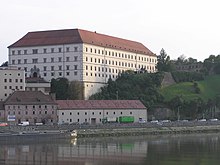Upper Austrian state museums
The Upper Austrian State Museum is a cultural institution of the State of Upper Austria . It consists of three main locations in Linz - the state gallery, the castle museum and the biology center - as well as several museums, memorials and collections throughout the federal state of Upper Austria. The Upper Austrian State Museum is managed on an interim basis by Bernhard Prokisch as scientific director and Walter Putschögl as commercial director.
history
In 1833 the “Association of the Patriotic Museum for Austria ob der Enns with the epitome of the Duchy of Salzburg” was founded on the initiative of Anton von Spaun . The association quickly gained influence and membership, and on January 28, 1839 Archduke Franz Karl took over the patronage.
The first building that was used as a museum was the “estate expeditor's house” on the promenade.
The exhibits were divided into four main areas in accordance with the association's statutes:
- historical and topographical collection
- art historical collection
- natural history collection
- technological collection
In addition to the association's own scientific work, donations from the nobility and from donations also contributed to the museum's holdings. Above all, the abbot of Wilhering Abbey , Johannes Baptist Anton Schober, as well as the Kremsmünster and St. Florian Abbey , which had scientific and art-historical collections and made parts of them available to the museum association, should be mentioned here.
After the death of the patron Archduke Franz Karl, the young Archduke Rudolf , who was primarily interested in the natural sciences, took over the patronage in 1878 .
The cramped conditions in the old museum meant that a new building in the historicist style was built on Museumsstrasse, which opened in 1895 and was named " Francisco-Carolinum " in honor of the former benefactor Franz Karl .
During the National Socialist era , the focus was on the natural history collection area, and a geological service was set up that was responsible for planning major projects at the time, such as the western motorway and various Enns power plants. There were plans to structurally outsource the natural science branch of the museum or to expand the museum, but the Second World War ruined these plans.
After the war there was still a shortage of space in the Francisco-Carolinum. That is why it was decided to convert the Linz Castle into a museum for cultural history, while contemporary art should now be shown in the Francisco-Carolinum.
In the eighties, a new building for a science museum was discussed. Even if in a less comprehensive framework than many wanted, the relevant exhibits of the State Museum found a new home in the Biology Center Linz-Dornach .
Facilities
The Upper Austrian provincial museums are spread over more than a dozen locations.
State Gallery Linz
The main building of the state museums, the “Francisco-Carolinum”, is located on Museumsstrasse in Linz. It was built from the mid-1880s to 1895 according to plans by the German architect Bruno Schmitz in the historicism style. The friezes and sculptural works were created by Melchior zur Straßen , while Adolf Obermüllner and Franz Attorner played a key role in the interior design .
Today, in addition to its function as the administrative building of the Upper Austrian museums, the Francisco-Carolinum is the location of the state gallery.
The Landesgalerie houses works of art from the 20th century, many of which have a clear reference to Upper Austria. The holdings include around 1,000 paintings, sculptures and room installations as well as around 30,000 graphics and photographs.
Castle Museum Linz
In the 1950s and early 1960s, the Linz Castle was converted into a museum. This castle museum was opened in 1966 and shows archaeological, cultural-scientific and cultural-historical holdings. In addition to painting and sculptural art from past centuries, everyday objects from Upper Austria are also on display.
In addition to the permanent exhibitions, several major exhibitions take place every year.
Biology Center Linz-Dornach
The natural science collection of the State Museum has been housed in the so-called "Biology Center" in Linz-Dornach since 1993. The biology center is the seat of the zoological and botanical database ZOBODAT .
More locations
The Upper Austrian provincial museums also include:
- Customs and financial history collection , Linz
- Military collection in Ebelsberg Castle , Linz
- Sumerauerhof open-air museum , Sankt Florian
- Anton Bruckner Museum , Ansfelden
- Kubin House , Zwickledt
- Photo museum in the Marmorschlössl , Bad Ischl
- Mühlviertel Castle Museum , Freistadt
- Upper Austria. Maritime Museum , Grein
- Stelzhamer Memorial , Pramet
- Römerbad & Römerpark , Schlögen
- Römerburgus in Oberranna, Engelhartszell community
management
- 1908–1937 Hermann Ubell
- 1937–1945 Theodor Kerschner
- 1945–1960 Wilhelm Albert von Jenny
- 1960–1975 Wilhelm Freh
- 1975–1978 Franz C. Lipp (from 1939 to 1978 head of the folklore department)
- 1979 Alfred Marks (interim)
- 1979–1984 Hermann Kohl
- 1984–1985 Benno Ulm (interim)
- 1985–1990 Wilfried Seipel
- 1991-2000 Gunter Dimt
- 2000–2013 Peter Assmann
- 2013–2018 Gerda Ridler (Commercial Director since 2012: Walter Putschögl)
- 2018–2020 Bernhard Prokisch (interim)
- since March 2020: Alfred Weidinger
literature
- Theodor Kerschner, Josef Schadler: History of the natural science collections of the Upper Austrian State Museum. In: Yearbook of the Upper Austrian Museum Association. Volume 85, Linz 1933, pp. 345–479, part 1 (PDF) in the forum OoeGeschichte.at, part 2 (PDF) in the forum OoeGeschichte.at.
Web links
- Official website at landesmuseum.at.
Individual evidence
- ↑ Kerschner / Schadler 1933, p. 347.
- ↑ Imprint. History and content on ZOBODAT
- ^ Hermann Kohl: Director's report 1933-1982. In: Yearbook of the Upper Austrian Museum Association. 128b, Linz 1983, PDF on ZOBODAT
- ↑ orf.at of June 28, 2019: Alfred Weidinger takes over the Landesmuseum ; accessed on June 28, 2019


